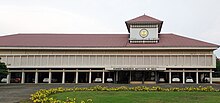Rubber Board
Commercial cultivation of natural rubber was introduced in India by the British, although the experimental efforts to grow rubber on a commercial scale in India were initiated as early as 1873 at the Botanical Gardens, Calcutta.
The importance of rubber production in India for strategic and security reasons had been realised by the government during the Second World War period.
After the war, there were growing demands from the growers for setting up a permanent organisation to look after the interests of the industry.
Thereupon the government set up an ad hoc committee in 1945 to study the situation and to make appropriate recommendation.
The Rubber (Amendment) Act of 1982 provided for the Central Government to appoint a part-time or whole time Chairman for the Board and, if necessary, an Executive Director for exercising such powers and performing such duties as may be prescribed or delegated to him by the Chairman.
[3] The development strategy for natural rubber production has to keep in view the following essential requirements: • Optimisation of production from existing plantations through replanting with improved cultivars and better agro management • Expansion of cultivation in traditional plantation areas, identification of suitable non-traditional areas that are fit for economic production and extension of cultivation to such areas • Reduction of cost of production to withstand challenges from competing crops, synthetic substitutes and cheap imports • Upgradation of quality of produce to meet the increasingly exacting demands of consuming industries • Formation and effective working of small holders’ self-help groups to ensure informed community participation to create infrastructure to facilitate organised production, processing and marketing chains to gain maximum returns.
The approach also takes care of the needs of the resource poor farmers who also got an opportunity not only to derive benefits offered under various schemes but to contribute to the decision making process.

